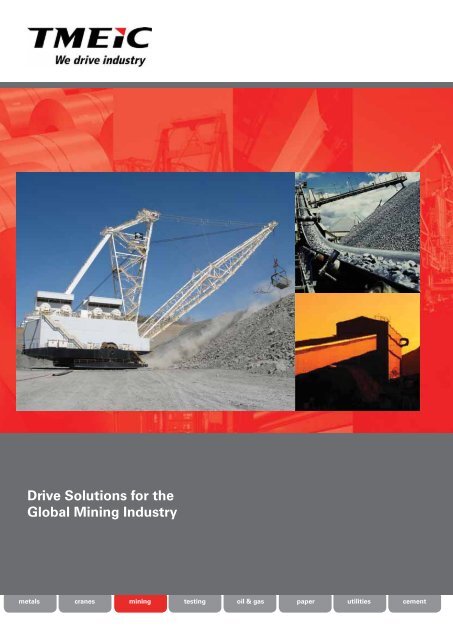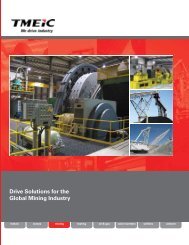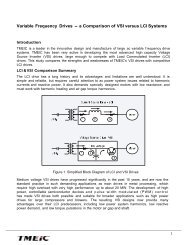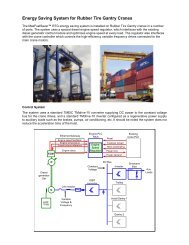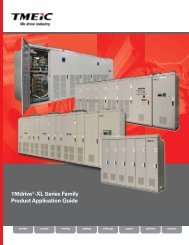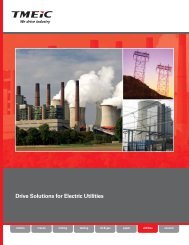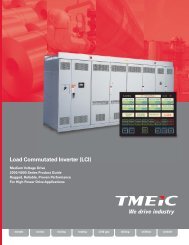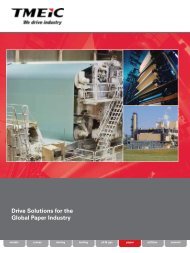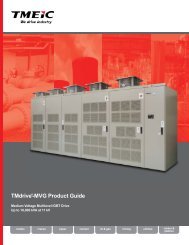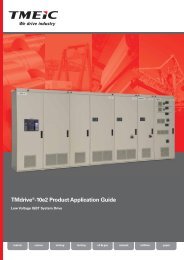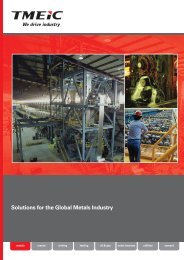Drive Solutions for the Global Mining Industry - Tmeic.com
Drive Solutions for the Global Mining Industry - Tmeic.com
Drive Solutions for the Global Mining Industry - Tmeic.com
You also want an ePaper? Increase the reach of your titles
YUMPU automatically turns print PDFs into web optimized ePapers that Google loves.
<strong>Drive</strong> <strong>Solutions</strong> <strong>for</strong> <strong>the</strong><br />
<strong>Global</strong> <strong>Mining</strong> <strong>Industry</strong><br />
metals cranes<br />
mining testing oil & gas paper utilities<br />
cement
About TMEIC<br />
A <strong>Global</strong> network<br />
TMEIC is built on <strong>the</strong> <strong>com</strong>bined and proud heritage<br />
of Toshiba and Mitsubishi-Electric in <strong>the</strong> industrial<br />
automation, control and drive systems business.<br />
TMEIC’s global business employs more than 2,200<br />
employees, with sales exceeding U.S. $2.4 billion, and<br />
specializes in Metals, Oil & Gas, Material Handling,<br />
Utilities, Cement, <strong>Mining</strong>, Paper and o<strong>the</strong>r industrial<br />
markets.<br />
TMEIC Corporation, headquartered in Roanoke,<br />
Virginia, designs, develops and engineers advanced<br />
automation and variable frequency drive systems.<br />
The factory <strong>for</strong> <strong>the</strong> World’s factories<br />
TMEIC delivers high quality advanced systems and<br />
products to factories worldwide, while serving as a<br />
global solutions partner to contribute to <strong>the</strong> growth of<br />
our customers.<br />
Customer Service<br />
At TMEIC, our focus is on <strong>the</strong> customer, working to<br />
provide superior products and excellent service,<br />
delivering customer success every project, every time.<br />
Variable Frequency <strong>Drive</strong>s in <strong>the</strong> <strong>Mining</strong> <strong>Industry</strong><br />
Every step of <strong>the</strong> way, from <strong>the</strong> mine to <strong>the</strong> finished<br />
product, variable frequency drives (VFDs) are used to<br />
smoothly start large motors and continuously adjust <strong>the</strong><br />
speed as required by <strong>the</strong> machine or process. Induction and<br />
synchronous motors driving excavators, conveyors,<br />
mills, fans, and pumps use VFDs to provide high power<br />
and speed control, as well as generate significant<br />
associated energy and maintenance savings.<br />
Hoists<br />
Draglines & Shovels<br />
Conveyors<br />
Grinding Mills<br />
Pumps<br />
• Large draglines and shovels require drives to<br />
provide high power to all <strong>the</strong> motors running <strong>the</strong><br />
machine with controlled torque and speed.<br />
• Long conveyors require drives <strong>for</strong> starting and<br />
running, in particular to provide controlled starting<br />
torque to avoid belt slip, and <strong>the</strong> ability to adjust<br />
speed to match processing needs.<br />
• The TMdrive ® -10/30/50/70 family of drives and<br />
TMEIC motors are also well-suited <strong>for</strong> mine hoist<br />
applications.<br />
• <strong>Drive</strong>s are useful in soft starting large mill motors.<br />
Motor life is extended by eliminating inrush<br />
currents. Low currents at start also benefit <strong>the</strong><br />
power delivery system by reducing voltage dips.<br />
Page 2 of 32<br />
© 2011 Toshiba Mitsubishi-Electric Industrial Systems Corporation, Japan. All Rights Reserved.
Why Use Electrical Variable Frequency <strong>Drive</strong>s?<br />
Here are some of <strong>the</strong> reasons to use VFDs in <strong>the</strong> mining industry:<br />
Increased Reliability Pages 4, 5, 9<br />
Variable frequency motor-drive systems are more reliable than traditional mechanical approaches<br />
such as using throttling valves, gears, or turbines to control speed and flow. Because electric drives<br />
have no moving parts, <strong>the</strong>y provide very high reliability. For example, <strong>the</strong> high MTBF of <strong>the</strong> Dura-<br />
Bilt5i MV drive allows us to offer a 5-year warranty <strong>for</strong> that product in North America.<br />
Good Control over Earth Moving Machines Pages 4, 5, 6<br />
Responsive speed and position control of large machines with mechanical functions such as hoist,<br />
swing, and drag, require powerful variable frequency drives. Long conveyors also require accurate<br />
torque and speed control provided by VFDs.<br />
Significantly Less Maintenance Pages 8, 19<br />
Mine equipment demands high system availability. Electric variable frequency drive systems have no<br />
moving parts, and are very low maintenance. This is in sharp contrast to speed control devices such<br />
as pumps, valves, gears, and turbines that do require extensive periodic maintenance with associated<br />
downtime.<br />
Soft Starting One or Multiple Mill Motors, and Improved Power Factor Pages 8, 9<br />
When electric drives soft start large motors, starting inrush current with associated heating and<br />
<strong>the</strong>rmal stress is eliminated. This removes limitations on motor frequency of starts, reduces insulation<br />
damage, and provides extended motor life. With synchronization logic, one drive can soft start multiple<br />
motors. Finally, large variable frequency drives can improve overall system power factor.<br />
Why TMEIC <strong>Drive</strong>s Make Sense<br />
Choose TMEIC, a <strong>Global</strong> Supplier Page 18<br />
TMEIC manufactures, sells and services drive systems worldwide, supported by engineering and<br />
service offices in North & South America, Europe, Asia, Japan and Australia.<br />
We’ve got you covered! A Complete Family of <strong>Drive</strong>s Pages 19<br />
Our family of low and medium voltage (LV and MV) drives covers all your needs from 450 hp up to<br />
12,000 hp (335 kW to 8,950 kW) and beyond, with a wide output voltage range up to 11 kV, and a line<br />
of dc drives and motor generator controls to meet your requirements.<br />
Engineering Expertise Pages 11<br />
TMEIC drive and motor application engineers bring an average of 25 years of practical industry<br />
experience to your application. After analyzing your system requirements, <strong>the</strong>y can re<strong>com</strong>mend <strong>the</strong><br />
most cost effective solution and design <strong>the</strong> <strong>com</strong>plete drive system <strong>for</strong> you.<br />
Configuration Software Pages 19, 20<br />
The world-class software configuration tool is used on all TMEIC drives. Live block diagrams and<br />
tune-up wizards streamline <strong>com</strong>missioning and maintenance activities.<br />
© 2011 Toshiba Mitsubishi-Electric Industrial Systems Corporation, Japan. All Rights Reserved. Page 3 of 32
<strong>Drive</strong> Applications <strong>for</strong> Draglines, Shovels, Conveyors, Mills, and Pumps<br />
AC and DC variable frequency drives are used to control <strong>the</strong> speed of draglines, conveyors, mills, hoists and<br />
pumps in <strong>the</strong> mining industry. The following pages describe four typical applications and present <strong>the</strong> reasons<br />
why electrical drives were chosen.<br />
Application 1. Advanced Control <strong>for</strong> MG Set Draglines and Shovels<br />
DC-EXX MG Set Control<br />
The DC-EXX is TMEIC’s motor generator control <strong>for</strong><br />
mining excavators. This control is a high-per<strong>for</strong>mance,<br />
innovative, hardware-software system built on proven<br />
technology and over 50 years of experience.<br />
The system is designed <strong>for</strong> multiple dc generators<br />
and motors used in large machines. Common-bus dc<br />
rectifiers feed IGBT (Insulated Gate Bipolar Transistors)<br />
field exciter-regulators, while a single high-speed PLC<br />
provides precise control and enables high excavator<br />
productivity.<br />
Overall Motor Generator Set System<br />
• Medium voltage ac power<br />
from <strong>the</strong> mine trail cable<br />
feeds MG set sync motors<br />
and auxiliary trans<strong>for</strong>mer.<br />
Aux ac Supply<br />
Main ac Supply<br />
Diode<br />
Rectifier<br />
Gen<br />
Exciter<br />
Gen<br />
Exciter<br />
Generator Field dc Bus<br />
• Each synchronous motor<br />
MG set powers multiple dc<br />
generators on a <strong>com</strong>mon<br />
shaft.<br />
Sync.<br />
Motor<br />
MG Set<br />
dc<br />
Gen<br />
Shaft<br />
dc<br />
Gen<br />
To o<strong>the</strong>r generators<br />
Motor Field dc Bus<br />
• Diode ac-dc converters<br />
on auxiliary power create<br />
two 600 volt <strong>com</strong>mon dc<br />
busses <strong>for</strong> generator and<br />
motor fields<br />
Motor<br />
Exciter<br />
Aux ac Supply<br />
Diode<br />
Rectifier<br />
Motor<br />
Exciter<br />
DC<br />
Motor<br />
Motor<br />
dc<br />
Motor<br />
DC-EXX Features<br />
Latest Technology<br />
• Common Bus – allows field power sharing<br />
• Low harmonics of diode vs. thyristor converters<br />
• IGBT power switches vs. thyristors<br />
• Replace field circuit dc contactors with thyristor<br />
More Control Features<br />
• <strong>Drive</strong> PLC sets limits, <strong>com</strong>munication, & operation<br />
modes<br />
• PLC master has motion protection & drive settings<br />
• Complete control during LE (Excitation) stop<br />
Superior Design<br />
• Current but proven technology<br />
• Fewer excitation trans<strong>for</strong>mers<br />
• Simpler drive internal controls<br />
• Small footprint<br />
• Lower total system cost<br />
Benefits<br />
Improved Per<strong>for</strong>mance<br />
• Smaller feed trans<strong>for</strong>mers and lower cost<br />
• Less heating & interference, smaller auxiliary trans<strong>for</strong>mer<br />
• Faster response, no cell state sensors, fewer devices<br />
• Less maintenance; same field circuit protection & braking<br />
Improved Control<br />
• Simplified supervisory PLC system & real-time monitoring<br />
• Visible functionality <strong>for</strong> easier monitoring & maintenance<br />
• Faster motion stop while protecting motors & generators<br />
Improved Value<br />
• Long product life<br />
• Less space, simpler, lower cost MCC and ac feeds<br />
• Easier troubleshooting and setup<br />
• Better and smaller panel layout and maintenance<br />
• Better value<br />
Page 4 of 32<br />
© 2011 Toshiba Mitsubishi-Electric Industrial Systems Corporation, Japan. All Rights Reserved.
Application 1 (continued). Latest Technology <strong>for</strong> DC MG Set Controls (Dragline Example)<br />
Operator HMI<br />
Onboard DL Systems<br />
Maintenance HMI<br />
Supervisory<br />
PLC<br />
<strong>Drive</strong><br />
Controller<br />
Touch Screen<br />
Converter<br />
Profibus<br />
T1<br />
LE<br />
Absorption<br />
chopper<br />
Generator Field DC Bus<br />
H S D1 D2<br />
DC-EXX<br />
Chopper<br />
Exciter<br />
(typical)<br />
Energy<br />
absorption<br />
resistors<br />
Gen.<br />
Fields<br />
Field<br />
protective<br />
crowbars<br />
Converter<br />
T2<br />
Motor Field DC Bus<br />
Sync. Motor<br />
Excitation<br />
typical<br />
dv/dt filter<br />
(typical)<br />
Motor<br />
Fields<br />
Hoist Swing Drag<br />
Propel<br />
dv/dt<br />
filter<br />
Detailed System Configuration<br />
Main Components<br />
• Medium voltage ac power from <strong>the</strong> mine trail<br />
cable feeds MG set synchronous motors and<br />
auxiliary trans<strong>for</strong>mer.<br />
• Each synchronous motor MG set powers multiple<br />
dc generators on a <strong>com</strong>mon shaft.<br />
• Diode ac-dc converters on auxiliary power create<br />
two 600 volt <strong>com</strong>mon dc busses <strong>for</strong> generator and<br />
motor fields.<br />
• Exciters use IGBT switches in a dc chopper<br />
configuration to feed filtered, controlled current to<br />
dc fields.<br />
• A high-speed drive controller <strong>for</strong> optimum digging<br />
and machine protection.<br />
• Dragline ac in<strong>com</strong>ing Power Factor is maintained<br />
by synchronous motor exciters fed from <strong>the</strong> dc<br />
motor <strong>com</strong>mon bus.<br />
• Machine supervisory PLC controls and protects<br />
excavator and <strong>com</strong>municates through operator<br />
and maintenance displays.<br />
• Profibus line to drives used <strong>for</strong> <strong>com</strong>mands and<br />
monitoring.<br />
Ruggedized DC-EXX Modules<br />
Exciter<br />
• 300 or 600 V dc in, 150, 300 and<br />
600 Amp output, output voltage<br />
to match field requirement.<br />
• Microprocessor controlled IGBT<br />
switches regulate armature<br />
voltage and current.<br />
• Film type internal capacitors <strong>for</strong><br />
wide temperature tolerance.<br />
• Receives operating <strong>com</strong>mands<br />
through Profibus input from<br />
drive controller.<br />
DC Converter<br />
• 220-440 V ac 3-phase<br />
input<br />
• 300-600 V dc output<br />
• 350 or 750 Amp<br />
output capacity<br />
• Static switches in <strong>the</strong> generator and motor fields<br />
provide field protection and controlled emergency<br />
stopping.<br />
© 2011 Toshiba Mitsubishi-Electric Industrial Systems Corporation, Japan. All Rights Reserved. Page 5 of 32
Application 2. AC <strong>Drive</strong>s <strong>for</strong> Draglines<br />
Utility<br />
Supply<br />
Input<br />
Reactors<br />
Operator<br />
Control<br />
O<strong>the</strong>r subsystems<br />
®<br />
TMdrive -<br />
P-30<br />
Active<br />
Converter<br />
TMdrive-30<br />
PWM<br />
Inverter<br />
Drag/Propel<br />
TMdrive-30<br />
PWM<br />
Inverter<br />
Drag<br />
TMdrive-30<br />
PWM<br />
Inverter<br />
Hoist<br />
TMdrive-30<br />
PWM<br />
Inverter<br />
Hoist<br />
TMdrive-30<br />
PWM<br />
Inverter<br />
Swing<br />
Supervisory<br />
PLC<br />
LAN<br />
Latched D/P<br />
Transfer<br />
Operator HMI<br />
D1 D2 H1 H2<br />
Maintenance<br />
Touch Panel<br />
P1<br />
P2<br />
One-line TMdrive-30 dragline configuration<br />
(Typical lineup – number required depends on dragline configuration)<br />
S1<br />
S2<br />
Main Components<br />
• In<strong>com</strong>ing power from <strong>the</strong> mine distribution<br />
system feeds <strong>the</strong> TM-30 converter via <strong>the</strong><br />
onboard trans<strong>for</strong>mer.<br />
• For three-level output, <strong>the</strong> TM-30 converter<br />
powers two, 900 V dc busses that are<br />
available to <strong>the</strong> entire line-up of <strong>the</strong><br />
inverters. The PWM converter is fully<br />
regenerative and can provide leading VARS<br />
<strong>for</strong> voltage stability.<br />
• Each drive inverter is connected to a motor<br />
<strong>for</strong> per<strong>for</strong>ming a particular motion of <strong>the</strong><br />
dragline.<br />
• The swing drive feeds <strong>the</strong> two swing motors<br />
(depending on motion HP), while <strong>the</strong> propel<br />
motion is shared with <strong>the</strong> drag drive. Hoist<br />
motors are supplied from dedicated drives.<br />
• The number of inverters per converter<br />
lineup depends on <strong>the</strong> peak and RMS power<br />
levels and required dragline power and<br />
reactive power characteristic needed <strong>for</strong><br />
mine voltage stability.<br />
• A machine supervisory PLC sends<br />
references to <strong>the</strong> drive and controls/protects<br />
<strong>the</strong> dragline while running.<br />
• Two touch-sensitive HMI displays are<br />
provided <strong>for</strong> easy maintenance, diagnostics<br />
and monitoring.<br />
• Communications between <strong>the</strong> drives and<br />
PLC can be provided via industry high-speed<br />
standard protocol like Profibus-DP.<br />
TMdrive-30 Cabinet line-up<br />
IGBT Three-Level Phase-leg<br />
Assembly<br />
The inverters and IGBT-based<br />
sources have modular threelevel<br />
phase leg assemblies.<br />
Each phase leg includes:<br />
• IGBTs with flyback diodes<br />
• Heat pipe assembly<br />
• IGBT gate driver circuit<br />
board<br />
• Heavy-duty slides allow easy<br />
access <strong>for</strong> maintenance<br />
• High-speed fuses<br />
Rack-out module<br />
Page 6 of 32<br />
© 2011 Toshiba Mitsubishi-Electric Industrial Systems Corporation, Japan. All Rights Reserved.
Application 3. Transporting Ore by Conveyor - Tough Speed and Torque Control<br />
A train transporting ore to a processing plant had be<strong>com</strong>e obsolete and unreliable. TMEIC’s solution was to replace<br />
<strong>the</strong> train with a conveyor to transport <strong>the</strong> ore. The conveyor was segmented into three pieces: Conveyor 1 lifts <strong>the</strong><br />
ore to <strong>the</strong> surface, Conveyor 2 moves <strong>the</strong> ore several miles, and Conveyor 3 moves <strong>the</strong> ore to <strong>the</strong> processing plant.<br />
The longest segment, Conveyor 2, is detailed below.<br />
Conveyor 2 Design Challenges<br />
Motor Challenges: The system required:<br />
• Motor powers up to 2250 hp with high starting<br />
torque<br />
• Wide speed range<br />
Motor Solution: 2.3 kV induction motors with<br />
separate cooling air system supplied by <strong>the</strong> user.<br />
<strong>Drive</strong> Challenges: The drives must be:<br />
• Reliable <strong>for</strong> continuous service<br />
• Energy efficient<br />
• Low maintenance<br />
<strong>Drive</strong> Solution: TMEIC ac drives <strong>for</strong> 2300 volt<br />
operation, with 3-level PWM inverters and 18-pulse<br />
rectifiers.<br />
Control Challenges: The system required:<br />
• Precise torque <strong>for</strong> belt tension control<br />
• Head to tail tension coordination<br />
• Variable speed operation of any motor.<br />
Control Solution: An Innovation Series controller<br />
Typical overland conveyor<br />
<strong>for</strong> torque programming.<br />
The Longest Conveyor Segment<br />
Four large drives and induction motors totaling 9,000 hp<br />
move <strong>the</strong> longest conveyor segment. High altitude required<br />
drive derating and attention to cooling. As shown below,<br />
<strong>the</strong> grade varies from 1% up to 5%.<br />
Power Challenges: The system required long<br />
power feeds, and needed to avoid capacitancecreated<br />
resonance at high order harmonics.<br />
Power Solution: The power system employs:<br />
• 3-level inverters with IEEE 519 <strong>com</strong>pliant,<br />
18-pulse converters<br />
• High frequency filters to eliminate cable<br />
resonance at 19th harmonic<br />
Conveyor 2<br />
13.8 kV<br />
GRADE = Variable 5% to 1%<br />
Conveyor 2<br />
Plan View<br />
2140 kVA<br />
13,800/2400 V<br />
Head end equipment<br />
house @9500 feet AMSL<br />
AC Pulse Width Modulated <strong>Drive</strong> System<br />
AC <strong>Drive</strong><br />
2300V 3 level<br />
Elev.<br />
9,500 ft.<br />
AC Motor<br />
2.3 kV<br />
1,000 or<br />
2,250 hp<br />
M<br />
2,400 ft.<br />
Elev.<br />
7,100 ft.<br />
Benefits of ac <strong>Drive</strong> System<br />
Very reliable system. Replacing <strong>the</strong><br />
train with <strong>the</strong> conveyor and variable<br />
frequency drive system resulted in:<br />
• High reliability<br />
• Reduction in maintenance & down<br />
time<br />
Variable speed brings benefits.<br />
Conveyor speed control resulted in<br />
several benefits:<br />
• Energy savings<br />
• Reduced friction<br />
• Reduced belt wear<br />
Technical risks avoided. Careful design<br />
avoided failure potentials such as<br />
slippage and stretch of <strong>the</strong> miles-long<br />
total belt length driven by 9,000 hp at<br />
<strong>the</strong> head end (four motors of 2,250 hp<br />
each).<br />
© 2011 Toshiba Mitsubishi-Electric Industrial Systems Corporation, Japan. All Rights Reserved. Page 7 of 32
Application 4. Grinding Mill Motors<br />
Customer installations at this plant use variable frequency drives <strong>for</strong> a number of applications. Four motors ranging<br />
from 250 to 2,400 hp are driven by TMEIC medium voltage drives. There are three large mill motors, each one requiring<br />
a medium voltage motor of 4,000 hp size.<br />
The customer had several requirements when<br />
selecting <strong>the</strong> three large mill motors, associated<br />
drives and controls, including:<br />
• Ability to soft start any of <strong>the</strong> motors from any<br />
drive and reduce <strong>the</strong> impact on <strong>the</strong> power system.<br />
• Ability to synchronize <strong>the</strong> motors with <strong>the</strong> utility<br />
supply and run some or all of <strong>the</strong> motors on <strong>the</strong><br />
utility supply at constant speed.<br />
• Ability to run one motor at variable frequency to<br />
allow grinding process optimization.<br />
• Use synchronous motors, because <strong>the</strong>y can supply<br />
leading VARs to <strong>the</strong> power supply system to help<br />
correct poor plant power factor.<br />
After reviewing alternatives, <strong>the</strong> customer decided to<br />
install a medium voltage Load Commutated Inverter<br />
(LCI) to individually soft start <strong>the</strong> three mill motors.<br />
Benefits of Variable Speed <strong>Drive</strong> and Synchronous Motors<br />
Cost savings. The customer’s analysis indicated excellent savings by using synchronous motors<br />
because <strong>the</strong>y correct <strong>the</strong> power factor <strong>for</strong> <strong>the</strong> whole plant, and <strong>the</strong>y have a high efficiency. In this<br />
location <strong>the</strong> utility charges users a penalty <strong>for</strong> low power factor operation.<br />
High reliability. The medium voltage LCI has a proven history of high reliability over <strong>the</strong> past 20 years:<br />
• N+1 SCR redundancy allows continued operation even if a SCR fails<br />
• Water cooled power modules<br />
• SCRs can be changed without opening <strong>the</strong> cooling circuit<br />
• The MTBF based on plant operation is over 15 years<br />
Smooth motor starting. The drive controls <strong>the</strong> rotor field (through <strong>the</strong> exciter) and <strong>the</strong> stator current<br />
to provide a smooth starting profile without exceeding rated volts and amps, <strong>the</strong>reby protecting <strong>the</strong><br />
motor against overheating. Controlling <strong>the</strong> motor current is also important where power system grids<br />
are weak or <strong>the</strong> plant is at <strong>the</strong> end of a long transmission line. In addition to starting, <strong>the</strong> drive provides<br />
smooth motor synchronizing with <strong>the</strong> supply.<br />
Page 8 of 32<br />
© 2011 Toshiba Mitsubishi-Electric Industrial Systems Corporation, Japan. All Rights Reserved.
Application 4 (continued). Multiplexing a <strong>Drive</strong> to Start & Control Three Large Mill Motors<br />
Starting<br />
<strong>Drive</strong><br />
Isolation<br />
Contactor<br />
Starting<br />
Contactors<br />
Mill<br />
Motors<br />
Motor<br />
Exciters<br />
34.5 KV<br />
MV<br />
<strong>Drive</strong><br />
IC1<br />
ST1<br />
MTR1<br />
4160 V<br />
M1<br />
ST2<br />
MTR2<br />
EX1<br />
Excitation<br />
Voltage<br />
Controller<br />
ST3<br />
MTR3<br />
EX2<br />
Excitation<br />
Voltage<br />
Controller<br />
M3<br />
Run Breakers<br />
EX3<br />
Excitation<br />
Voltage<br />
Controller<br />
One-line <strong>for</strong> multi-motor start by a VFD<br />
Shared <strong>Drive</strong> Starting System is Cost Effective<br />
All three grinding mills are driven by synchronous<br />
motors of identical ratings. One drive can start<br />
any of <strong>the</strong> three motors in any desired sequence as<br />
shown by <strong>the</strong> blue lines in <strong>the</strong> figure above. Once <strong>the</strong><br />
synchronous motor is started, <strong>the</strong> drive synchronizes<br />
<strong>the</strong> motor with <strong>the</strong> supply to operate directly across<br />
<strong>the</strong> line.<br />
As soon as <strong>the</strong> first mill motor is started and bypassed<br />
to <strong>the</strong> line, <strong>the</strong> drive is available to start <strong>the</strong> second<br />
mill. The same process is repeated to make <strong>the</strong> drive<br />
available <strong>for</strong> starting <strong>the</strong> third mill.<br />
All three mills can operate directly across <strong>the</strong> line, or<br />
one can remain connected to <strong>the</strong> drive <strong>for</strong> variable<br />
frequency operation if required. Because of <strong>the</strong><br />
sharing, this system minimizes <strong>the</strong> customer’s capital<br />
cost.<br />
Synchronous Transfer<br />
The drive is responsible <strong>for</strong> <strong>the</strong> actual phase and<br />
voltage matching <strong>for</strong> <strong>the</strong> final transfer of <strong>the</strong> motor<br />
to utility operation. This transition is coordinated to<br />
within a few milliseconds that eliminate damaging<br />
torques or loss of motor synchronization.<br />
Soft Starting<br />
The drive keeps <strong>the</strong> motor starting currents below<br />
full load amps at all times. Starting <strong>the</strong> motor across<br />
<strong>the</strong> line without <strong>the</strong> drive, <strong>the</strong> starting inrush current<br />
is six times full current. Using <strong>the</strong> drive, motor stress<br />
is significantly reduced and motor life is extended.<br />
© 2011 Toshiba Mitsubishi-Electric Industrial Systems Corporation, Japan. All Rights Reserved. Page 9 of 32
Application 5. Slip Power Recovery <strong>Drive</strong> System <strong>for</strong> Grinding Mill<br />
This ore processing facility in Papua New Guinea can process up to 4.7 million tons of ore per year. The variable<br />
frequency drive application is a dual-pinion SAG mill driven by two 5,000 kW wound rotor induction motors (WRIM).<br />
Two TMdrive-10SPRs control motor speed by recovering rotor current and returning <strong>the</strong> power to <strong>the</strong> utility supply.<br />
Configured in a twin motor arrangement, <strong>the</strong> motors share load in <strong>the</strong> tandem mill.<br />
The Customer Need<br />
Reliability, power dependency and logistics were a challenge <strong>for</strong> this project. Limited access to <strong>the</strong> mine’s remote<br />
location required power recovery and stellar reliability in its operations.<br />
Grinding Mill Design Challenges<br />
Motors: Two, 5,000 kW Wound Rotor Induction Motors<br />
• Twin motor application<br />
• One motor provides speed control, one provides torque<br />
control<br />
• Motors share <strong>the</strong> load in <strong>the</strong> tandem mill<br />
<strong>Drive</strong> Challenges: The drives must be:<br />
• Reliable <strong>for</strong> continuous service<br />
• Energy efficient and Low maintenance<br />
<strong>Drive</strong> Solution: TMdrive-10 SPR drive <strong>for</strong> each motor<br />
• Two, 690 VAC TMdrive-10SPR line-ups with 1800 frame<br />
converters and inverters<br />
• <strong>Drive</strong> power level is only 750 kW<br />
Control Challenges: The system required:<br />
• Speed range 85% - 110% rated speed<br />
• Variable speed operation of motors<br />
Control Solution: 1800 frame Toshiba V Series PLCs<br />
Power Challenges:<br />
Power Solution: Slip Power Recovery.<br />
• TMdrive-10SPR Slip Power Recovery drives<br />
• Continuously recovers an estimated 770 kW<br />
SAG Mill and Motor<br />
Benefits of Slip Power Recovery <strong>Drive</strong><br />
Very reliable system. Standard low voltage drive hardware, with a proven track record <strong>for</strong> per<strong>for</strong>mance<br />
and reliability.<br />
• High reliability is suitable <strong>for</strong> <strong>the</strong> remote location<br />
• Reduction in maintenance and down time<br />
• Inherent fault tolerance - a failure of <strong>the</strong> SPR drive will not prevent <strong>the</strong> motor’s operation<br />
Energy efficient<br />
• The SPR drive offers high overall system efficiency, thus saving energy and lowering operating costs<br />
• Can per<strong>for</strong>m additional VAR <strong>com</strong>pensation utilizing extra capacity in <strong>the</strong> converters<br />
Latest <strong>Drive</strong> Technology<br />
• Modern drive control provides <strong>the</strong> latest drive <strong>com</strong>munications, operating accuracy, and diagnostics<br />
• Standard TMEIC low voltage drive hardware is applied <strong>for</strong> use as a wound rotor motor drive<br />
• The TMdrive-10 drive hardware requires no modifications in <strong>the</strong> slip power recovery drive application<br />
Precise control of wound rotor motor while conserving energy<br />
• Soft starts <strong>the</strong> mill motors<br />
• <strong>Drive</strong>s control motor torque (rotor current) directly; motors do not have to increase slip (slow down)<br />
to increase torque, providing faster control response than Liquid Rheostat Control<br />
• Slip power is recovered and fed back to power system, saving energy<br />
Page 10 of 32<br />
© 2011 Toshiba Mitsubishi-Electric Industrial Systems Corporation, Japan. All Rights Reserved.
Application 5 (continued). Slip Power Recovery <strong>Drive</strong> System <strong>for</strong> Grinding Mill<br />
SAG Mill Operator’s Screen (HMI)<br />
The SAG mill operator’s control screen shown<br />
illustrates <strong>the</strong> two wound rotor motors M1<br />
and M2. Liquid rheostat starters on <strong>the</strong> right<br />
are switched in be<strong>for</strong>e starting and switched<br />
out when <strong>the</strong> motor reaches SPR regulating<br />
speed.<br />
Recovered slip power from <strong>the</strong> rotor flows<br />
to <strong>the</strong> left through <strong>the</strong> slip power recovery<br />
drives and out through <strong>the</strong> trans<strong>for</strong>mers to<br />
<strong>the</strong> supply.<br />
Motor speeds up to 110% of synchronous<br />
speed are possible, if torque and horse<br />
power limitations are observed.<br />
Electric power savings using Slip Power<br />
Recovery are considerable. An example<br />
calculation is shown on <strong>the</strong> next page.<br />
Slip Power recovery<br />
at normal speeds<br />
Utility Interface<br />
Trans<strong>for</strong>mer<br />
Motor Stator<br />
Utility<br />
Supply<br />
PWM Rotor<br />
Converter<br />
PWM Source<br />
Converter<br />
TMdrive-10SPR<br />
Brushes and<br />
Slip Rings<br />
Wound Rotor<br />
Induction Motor<br />
Liquid<br />
Rheostat<br />
One-line of SPR operation<br />
Starting duty rated<br />
SPR Operation<br />
The TMdrive-10SPR takes power out of <strong>the</strong> rotor to reduce <strong>the</strong> motor speed. At reduced speeds, power flows out of<br />
<strong>the</strong> rotor through <strong>the</strong> SPR to <strong>the</strong> trans<strong>for</strong>mer and back into <strong>the</strong> supply, instead of being dissipated in <strong>the</strong> rheostat.<br />
The SPR provides <strong>the</strong> highest efficiency VFD configuration because only a fraction of <strong>the</strong> motor power goes through<br />
<strong>the</strong> drive, in this case only 750 kW, out of 5,000 kW motor power. During startup <strong>the</strong> rheostat is connected to <strong>the</strong> rotor<br />
and <strong>the</strong> SPR is disconnected. Once up to minimum speed, <strong>the</strong> SPR drive is connected and <strong>the</strong> rheostat disconnected.<br />
The motor speed is <strong>the</strong>n controlled by <strong>the</strong> SPR.<br />
© 2011 Toshiba Mitsubishi-Electric Industrial Systems Corporation, Japan. All Rights Reserved. Page 11 of 32
Calculating Recovered Energy Savings<br />
P1 Utility 3-phase<br />
supply power<br />
flow<br />
P1 Utility 3-phase<br />
supply power<br />
flow<br />
P5 Slip Power<br />
recovery flow<br />
Wound Rotor<br />
Induction Motor<br />
P2 Utility Power flow<br />
to motor stator<br />
Wound Rotor<br />
Induction Motor<br />
Trans<strong>for</strong>mer<br />
TMdrive-10SPR<br />
Low Voltage<br />
<strong>Drive</strong><br />
P4 Power flow to Rheostat<br />
P3 Motor shaft<br />
power flow<br />
Rheostat<br />
Starting and<br />
Speed Control<br />
P2 Power flow<br />
to motor stator<br />
P3 Motor shaft<br />
power flow<br />
P4 Power flow<br />
to SPR drive<br />
Rheostat<br />
Starting Duty Rated<br />
Grinding<br />
Mill load<br />
Grinding<br />
Mill load<br />
Wound Rotor Induction Motor<br />
with Starting Rheostat<br />
Wound Rotor Induction Motor<br />
with Slip Power Recovery<br />
Comparison of Wound Rotor Induction Motor Control Systems<br />
Calculations <strong>for</strong> <strong>the</strong> energy savings with <strong>the</strong> SPR drive are shown below. Note that <strong>the</strong> slip power varies with <strong>the</strong> slip<br />
speed (synchronous speed minus <strong>the</strong> actual motor speed).<br />
Calculation of Savings with Slip Power Recovery <strong>Drive</strong><br />
Energy Efficiency<br />
Basic Equations<br />
Energy efficiency of <strong>the</strong> <strong>com</strong>ponents are estimated<br />
as follows:<br />
For <strong>the</strong> slip power recovery case above, <strong>the</strong> basic energy<br />
flow equations are:<br />
• SPR drive efficiency = 0.97<br />
• P1 = Motor Power - Recovered Power<br />
• Trans<strong>for</strong>mer efficiency = 0.99<br />
= P2-P5 where<br />
• Motor efficiency = 0.95<br />
• P2 = P3 + Motor Losses + Rotor Power<br />
• Slip power from <strong>the</strong> rotor (est.), P4:<br />
= P3/(Motor Efficiency) + P4<br />
Full Load x Slip % = 373 kW<br />
• P5 = P4 x <strong>Drive</strong> Efficiency x Trans<strong>for</strong>mer Efficiency<br />
Operating Conditions<br />
Mill Load at Full Speed, shaft kW<br />
Mill load at 90% speed, shaft kW<br />
Power flow from Slip Rings (est.)<br />
Power flow to motor (95) efficient)<br />
Slip power recovery after trans<strong>for</strong>mer<br />
Utility supply power flow<br />
Difference in utility power used<br />
P1(WRM) - P1(SPR)<br />
Power<br />
Flow<br />
–<br />
P3<br />
P4<br />
P2<br />
P5<br />
P1<br />
Wound Rotor Motor (WRM)<br />
with Rheostat<br />
3730 kW (5,000 hp)<br />
3357 kW (assume linear)<br />
373 kW (to rheostat)<br />
3906 kW<br />
0 kW<br />
3906 kW<br />
358 kW<br />
WRM with Slip Power<br />
Recovery <strong>Drive</strong><br />
3730 kW (5,000 hp)<br />
3357 kW<br />
373 kW (to SPR drive)<br />
3906 kW<br />
358 kW<br />
3548 kW<br />
SPR System Annual Savings with 7¢ electrical power<br />
$200,480 per year (8000 hours)<br />
Page 12 of 32<br />
© 2011 Toshiba Mitsubishi-Electric Industrial Systems Corporation, Japan. All Rights Reserved.
Project Engineering<br />
General Industries Team<br />
Experienced <strong>Drive</strong> Engineering Team<br />
The drive engineering team’s experience<br />
in <strong>the</strong> mining industry was gained through<br />
years of working in mines with technicians<br />
and mechanical suppliers. This engineering<br />
background, coupled with state-of-<strong>the</strong>-art<br />
technology, enables TMEIC to consistently<br />
meet <strong>the</strong> very demanding requirements of<br />
<strong>the</strong> industry.<br />
Experienced drive engineers jointly define<br />
<strong>the</strong> drive equipment and control strategy<br />
with your engineers and <strong>the</strong> OEM. This is<br />
followed by detailed design of <strong>the</strong> system,<br />
control logic, and configuration of <strong>the</strong><br />
drives.<br />
Local Commissioning Team Ensures<br />
Knowledgeable Ongoing Service<br />
Our globally-based field organization<br />
has extensive experience in <strong>the</strong> industry<br />
providing you with a strong service<br />
presence <strong>for</strong> startup and ongoing service<br />
work.<br />
Project Life Cycle Process Minimizes Risk<br />
Project Life Cycle Process<br />
The Project Teams<br />
Customer Team<br />
Technical<br />
Proposal<br />
Specification<br />
Detailed Hardware<br />
& Software Design<br />
& Component<br />
Procurement<br />
Factory<br />
Acceptance<br />
Test<br />
System<br />
Commissioning<br />
System<br />
Maintenance<br />
and Service<br />
Field Team<br />
Factory Team<br />
Training Team<br />
We understand that delay in your equipment<br />
<strong>com</strong>missioning is very expensive, so we take steps<br />
to hold our startup schedule. Our project engineering<br />
is based on <strong>the</strong> Project Life Cycle Process illustrated<br />
above and described in <strong>the</strong> following pages.<br />
• Project management provides a single point of<br />
contact from initial order to final <strong>com</strong>missioning.<br />
• Complete factory tests are conducted including<br />
applying power to <strong>the</strong> drive bridges and exercising<br />
<strong>the</strong> control system using motor and load simulators.<br />
• The local <strong>com</strong>missioning engineers are included<br />
in <strong>the</strong> project team, allowing a seamless transition<br />
from <strong>the</strong> factory to your mine.<br />
© 2011 Toshiba Mitsubishi-Electric Industrial Systems Corporation, Japan. All Rights Reserved. Page 13 of 32
The Medium Voltage VFD System<br />
TMEIC application engineers consider <strong>the</strong> system from <strong>the</strong> medium voltage switchgear to <strong>the</strong> adjustable speed drive<br />
and motor, sizing and selecting required equipment <strong>for</strong> <strong>the</strong> optimal drive solution. A typical MV VFD system is shown<br />
below.<br />
Instrumentation <strong>for</strong> equipment<br />
metering, monitoring, protection<br />
and control is selected:<br />
- Amp transducer and ammeter<br />
- Watt and Watt-hr transducers<br />
- Phase CTs and phase<br />
overcurrent relay<br />
- Ground sensor CT and relay<br />
- Power quality monitor<br />
Selection of optional drive associated<br />
equipment<br />
- Heat exchangers if required<br />
- Air conditioned equipment house if<br />
required<br />
- Switchgear if motor is to be synchronized<br />
with <strong>the</strong> line<br />
- PLC <strong>for</strong> logic control<br />
- Reactor <strong>for</strong> use with an LCI<br />
Selection of <strong>the</strong> motor<br />
- Induction, synchronous, wound rotor<br />
or dc motor<br />
- Motor specs including power,<br />
torque, voltage, current, and speed<br />
- Selection of exciter <strong>for</strong> sync motor<br />
- Required motor protection devices<br />
- Optional tachometer<br />
- Optional Torsional analysis<br />
<strong>Drive</strong> Isolation<br />
Trans<strong>for</strong>mer<br />
M<br />
Load<br />
Substation<br />
Trans<strong>for</strong>mer<br />
Distribution Voltages<br />
Adjustable speed<br />
<strong>Drive</strong><br />
<strong>Drive</strong> Utilization Voltage<br />
Motor<br />
Breaker<br />
MV Switchgear is selected <strong>for</strong> <strong>the</strong><br />
application considering:<br />
- The type, such as vacuum or SF6<br />
- The size <strong>for</strong> <strong>the</strong> current and voltage<br />
- The CTs, PTs, and protective relays<br />
to operate <strong>the</strong> breaker<br />
- The enclosure <strong>for</strong> outdoor or indoor<br />
- The environment, such as<br />
temperature and humidity<br />
<strong>Drive</strong> Isolation trans<strong>for</strong>mers, input and<br />
output, are selected <strong>for</strong> <strong>the</strong> application<br />
considering:<br />
- The type, such as dry or liquid filled<br />
- Size <strong>for</strong> <strong>the</strong> kVA and voltage<br />
- Cooling, if required<br />
- The enclosure <strong>for</strong> outdoor or indoor<br />
- The environment, such as<br />
temperature and humidity<br />
Selection of <strong>the</strong> best adjustable speed<br />
drive <strong>for</strong> <strong>the</strong> application:<br />
- Continuous and overload torque<br />
and power requirements<br />
- Type of load, including constant or<br />
variable torque, regenerative<br />
- <strong>Drive</strong> and motor voltage<br />
- Power system <strong>com</strong>patibility<br />
- Overall efficiency of <strong>the</strong> ASD and<br />
motor <strong>com</strong>bination<br />
- Harmonic analysis<br />
Page 14 of 32<br />
© 2011 Toshiba Mitsubishi-Electric Industrial Systems Corporation, Japan. All Rights Reserved.
Project Planning and Specification<br />
DB5i MV Unit A<br />
Sync Ready<br />
3-phase<br />
Utility Voltage Bus<br />
PLC Coordination<br />
& Interface<br />
Contactor<br />
DB5i MV Unit B<br />
Sync Ready<br />
3-phase<br />
1 CPT<br />
2 PTs<br />
Mtr 1 Mtr 2 Mtr 3<br />
Bypass Bus<br />
VFD Bus<br />
CT-1 CT-4 CT-5<br />
During all phases of your project<br />
planning, TMEIC assists you by<br />
supplying in<strong>for</strong>mation, training,<br />
guide-<strong>for</strong>m specifications, and<br />
general advice. Experienced drive<br />
application engineers prepare a<br />
technical proposal that includes:<br />
• Customized system architecture<br />
<strong>for</strong> your project.<br />
• Detailed equipment<br />
specifications <strong>for</strong> <strong>the</strong> drives,<br />
motors, exciters, trans<strong>for</strong>mers,<br />
switchgear, and housings.<br />
• Thorough description of <strong>the</strong> PLC<br />
and o<strong>the</strong>r control functions.<br />
• Formal bid documentation.<br />
Detailed Hardware/Software Design<br />
and Procurement<br />
Based on <strong>the</strong> proposal specification, <strong>the</strong> project<br />
engineering team proceeds with four main tasks:<br />
• Control Software Design. Control engineers<br />
configure <strong>the</strong> drives and PLC controller logic, if a PLC<br />
is required <strong>for</strong> <strong>the</strong> application. The illustration shows<br />
a typical toolbox logic function diagram in Relay<br />
Ladder Diagram <strong>for</strong>mat. The software tool is used <strong>for</strong><br />
drive configuration, tuning, sequencing, and drive<br />
diagnostics.<br />
• Optional HMI Screen Design. Interface screens <strong>for</strong><br />
maintenance and drive control can be configured.<br />
For example, <strong>the</strong> configurable keypad shown here<br />
provides real-time drive data and operator interaction.<br />
• Hardware Design. All equipment is specified to meet<br />
<strong>the</strong> project requirements, and a <strong>com</strong>plete set of<br />
elementary diagrams, layout, and outline drawings is<br />
created.<br />
• Component Procurement. We work with our parent<br />
and partner suppliers to source <strong>the</strong> most cost effective<br />
system <strong>com</strong>ponents <strong>for</strong> your application.<br />
Electrical prints<br />
<strong>Drive</strong><br />
configuration<br />
Keypad<br />
configuration<br />
© 2011 Toshiba Mitsubishi-Electric Industrial Systems Corporation, Japan. All Rights Reserved. Page 15 of 32
<strong>Drive</strong> and System Test<br />
Understanding <strong>the</strong> importance of a<br />
thorough drive and system test, <strong>the</strong><br />
TMEIC engineering team conducts<br />
factory tests be<strong>for</strong>e shipment. <strong>Drive</strong> tests<br />
in <strong>the</strong> factory typically include:<br />
Dura-Bilt5i MV<br />
<strong>Drive</strong> Testing<br />
• Full voltage and current check of power<br />
cells, insulation, and control circuits.<br />
• Acceleration and run test with unloaded<br />
motor.<br />
• Full current test into a reactor (ac<br />
drives).<br />
• Validation of all I/O interfaces.<br />
• Validation of <strong>the</strong> drive test modes and<br />
any special logic, or optional PLC using<br />
motor and load simulator.<br />
Software tool <strong>for</strong> <strong>Drive</strong> and<br />
Logic Configuration<br />
Digital Motor<br />
Simulator<br />
Digital Load<br />
Simulator<br />
Control System Test<br />
Factory validation of <strong>the</strong> drive<br />
control system is available as<br />
an option.<br />
Optional PLC with Logic, <strong>for</strong><br />
example, to soft-start multiple<br />
motors.<br />
M<br />
Load<br />
PLC<br />
<strong>Drive</strong> Simulator Software<br />
<strong>Drive</strong> Control<br />
CPU<br />
Logic Control<br />
Operator’s Keypad<br />
I/O Interface<br />
LAN Interface<br />
<strong>Drive</strong> Microprocessor Controller<br />
Local Area Network to dcS<br />
System Commissioning<br />
In <strong>the</strong> <strong>com</strong>missioning phase, <strong>the</strong> TMEIC team includes <strong>the</strong> field<br />
engineers you know and trust, alongside <strong>the</strong> engineer who designed<br />
and tested <strong>the</strong> system. This overlap of teams between engineering<br />
design and <strong>the</strong> site ensures a smooth and on-schedule startup.<br />
The TMEIC service engineer, who is responsible <strong>for</strong> startup and<br />
<strong>com</strong>missioning, and <strong>for</strong> any future service required at <strong>the</strong> site, is<br />
part of <strong>the</strong> project team and participates in <strong>the</strong> factory system test<br />
to be<strong>com</strong>e familiar with <strong>the</strong> system. Commissioning is supported<br />
by TMEIC design and service engineers.<br />
Complete & Detailed System Documentation<br />
Along with <strong>the</strong> hardware and software, TMEIC delivers <strong>com</strong>plete<br />
system documentation:<br />
• An electronic instruction book with all <strong>the</strong> prints on CD with a<br />
hyperlink index;<br />
• Re<strong>com</strong>mended wiring and grounding procedures;<br />
• Renewal parts list; and<br />
• Standard third-party vendor documentation.<br />
• Validation of <strong>the</strong> drive test modes and any special logic, or optional<br />
PLC using motor & load simulator.<br />
Page 16 of 32<br />
© 2011 Toshiba Mitsubishi-Electric Industrial Systems Corporation, Japan. All Rights Reserved.
<strong>Global</strong> Customer Support Network<br />
Service and Training<br />
Comprehensive technical service is provided by our Customer Support Organization, staffed by TMEIC service<br />
engineers with offices and spare parts depots across <strong>the</strong> globe.<br />
In North and South America<br />
Customers are supported by <strong>the</strong> TMEIC Corporation<br />
service personnel, design engineers and Spare Parts<br />
Depot in Virginia, and <strong>the</strong> TMEIC Factory in Japan.<br />
In Europe<br />
TMEIC service engineers service all drive systems in<br />
Europe, supported by <strong>the</strong> European TMEIC Spare Parts<br />
Depot.<br />
In Asia and <strong>the</strong> Pacific Rim<br />
TMEIC services drive systems throughout China,<br />
India and <strong>the</strong> Pacific Rim, supported by multiple Field<br />
Engineers, Spare Parts Depots, and <strong>the</strong> TMEIC factory<br />
in Japan.<br />
Remote <strong>Drive</strong> Diagnostics<br />
TMEIC supports drive customers through <strong>the</strong> Remote<br />
Connectivity Module (RCM), a remote diagnostic<br />
service link with <strong>the</strong> TMEIC design and service<br />
engineers in Roanoke, Virginia. The RCM enables<br />
seamless integration between your drives and our<br />
engineers.<br />
Remote System Diagnostics<br />
TMEIC’s remote system diagnostics tool, included<br />
in level 1 software, offers a quick path to problem<br />
resolution. System faults are automatically identified,<br />
and provide an integrated view of product, process<br />
and system in<strong>for</strong>mation. TMEIC design and service<br />
engineers in Roanoke, Virginia, can analyze <strong>the</strong> data<br />
and provide steps <strong>for</strong> resolution.<br />
For Service or Parts, call<br />
1-877-280-1835<br />
INTERNATIONAL:<br />
+1-540-283-2010<br />
24 Hours / 7 days<br />
<strong>Drive</strong> Training at our Training Center or in Your Facility<br />
Customer engineers, maintenance and operations<br />
personnel are trained on <strong>the</strong> drives and control system<br />
at <strong>the</strong> TMEIC Training Center in Virginia. This world-class<br />
facility features large classrooms and fully-equipped<br />
training labs.<br />
Classroom and hands-on training consists of 50% class<br />
time and 50% hands-on lab time. Topics include:<br />
• Overview of <strong>the</strong> drive system<br />
• Function of <strong>the</strong> main assemblies<br />
• Technical details of <strong>the</strong> <strong>com</strong>ponents<br />
• <strong>Drive</strong> and control system tools<br />
• System diagnostics and service<br />
As an alternative to <strong>the</strong> standard factory training in Virginia,<br />
TMEIC can offer a course tailored to your project and held<br />
at your location. In this case, a project engineer trains your<br />
operators, maintenance technicians and engineers in your<br />
facility.<br />
© 2011 Toshiba Mitsubishi-Electric Industrial Systems Corporation, Japan. All Rights Reserved. Page 17 of 32
A Family of <strong>Drive</strong>s up to 11 kV<br />
TMdrive-DC<br />
TMdrive-10e2<br />
TMdrive-10SPR<br />
TMdrive-30<br />
TMdrive-70<br />
Dura-Bilt5i MV<br />
TMdrive-XL55<br />
TMdrive-MVG<br />
6.6 kV<br />
3.3 - 11 kV<br />
3.3<br />
Power Ratings<br />
TMdrive-MVG<br />
TMdrive-XL55<br />
TMdrive-50/70/80<br />
2.3 & 4.6 kV<br />
LCI<br />
(MV motor with LV Slip Power Recovery drive)<br />
Dura-Bilt 5i MV<br />
TMdrive-10SPR<br />
1200 V TMdrive-30<br />
AC Low Voltage<br />
280-690 V AC<br />
DC Armature<br />
230 to 1200 V DC<br />
MG Set<br />
Control<br />
TMdrive-MVG<br />
DC EXX<br />
TM-DC<br />
20 40 100 200 300 400 1,000 2,000 4,000 10,000 20,000 kW<br />
27 54 134 268 402 536 1,340 2,682 5,364 13,400 26,820 Hp<br />
TMEIC’s Family of AC and DC System <strong>Drive</strong>s<br />
Over 50 years of <strong>Drive</strong> Experience. Starting with dc<br />
drives, we later introduced ac drives, such as <strong>the</strong><br />
<strong>the</strong> new technology Tosvert, Dura-Bilt 5i MV, and<br />
TMdrives. Since 1979 over 2 million hp of TMEIC<br />
ac drives have been installed and are in service,<br />
representing <strong>the</strong> largest installed base of MV drives<br />
of any manufacturer.<br />
AC drive Voltages up to 11 kV. The family of ac drives<br />
offers voltages from 380 V with <strong>the</strong> TMdrive-10 up<br />
to 11kV with <strong>the</strong> TMdrive-MVG. The dc drive family<br />
covers 230 to 1200 vdc<br />
Significant Investment in <strong>Drive</strong> Technology. TMEIC’s<br />
Dura-Bilt and TMdrive products represent a large<br />
investment in LV and MV drive technology, including<br />
development of semiconductor devices such as <strong>the</strong><br />
IEGT and GCT.<br />
The Highest Reliability. TMEIC drives provide <strong>the</strong><br />
highest reliability based on field experience and<br />
customer satisfaction survey results.<br />
Configuration Software. The TMdrive Navigator<br />
world-class configuration software is used on all<br />
TMEIC drives. Live block diagrams and tune-up<br />
wizards streamline <strong>com</strong>missioning and maintenance<br />
activities.<br />
Spare Parts Stock. TMEIC’s parts depots stock <strong>the</strong> line<br />
of LV and MV drive parts to provide rapid delivery to<br />
your facility anywhere in <strong>the</strong> world.<br />
Page 18 of 32<br />
© 2011 Toshiba Mitsubishi-Electric Industrial Systems Corporation, Japan. All Rights Reserved.
TMdrive ® -10 Low Voltage System <strong>Drive</strong><br />
575/690 AC<br />
440/460 AC<br />
Volts<br />
The TMdrive-10 family of low voltage ac system drives has an<br />
integral dc bus structure with a wide variety of inverters (dc to<br />
ac) and converters (ac to dc) to match diverse needs. There are<br />
four voltage levels – 440, 460, 575, and 690 V ac.<br />
50<br />
67<br />
100<br />
134<br />
200<br />
268<br />
1000 2000 kW<br />
1,340 2680 Hp<br />
Converter power level ranges are:<br />
• Non-regenerative, 150 kW – 3600 kW<br />
• Regenerative, 100 kW – 1417 kW<br />
Inverter power level ranges are:<br />
• With dc disconnects, 3.1 kW – 1182 kW<br />
• Without dc disconnects, 141 kW – 1454 kW<br />
Draw-out Inverter trays stack eight to a 32-inch wide cabinet. The<br />
power level ranges are:<br />
• Single high trays, 3.1 kW – 63 kW<br />
• Double high trays, 101 kW – 106 kW<br />
Inverter power bridges use Insulated Gate Bipolar Transistors<br />
(IGBT). The type of modulation is two-level voltage using pulse<br />
width modulation (PWM).<br />
TMdrive ® -10SPR Slip Power Recovery <strong>for</strong> Wound Rotor Motors<br />
The Slip Power Recovery (SPR) version of <strong>the</strong> TMdrive-10 provides speed control of a wound rotor motor and efficient<br />
recovery of slip power from <strong>the</strong> rotor. This is discussed in Application 4 on page 10. Features of <strong>the</strong> SPR<br />
include:<br />
- Significant energy savings and low cost of ownership<br />
- The highest efficiency adjustable speed drive<br />
- Pulse width modulated converter<br />
- Reliability<br />
- High power factor operation<br />
- High MV Motor: <strong>for</strong> wound rotor motors, from<br />
pulse width modulated converter 1,000 – 10,000 hp<br />
Speed Range: depends on rotor<br />
voltage; super synchronous speed<br />
operation is available<br />
I/O, LAN Interface, & Cabinet Size:<br />
same as TMdrive-10.<br />
SPR Operation<br />
The TMdrive-10SPR takes power<br />
out of <strong>the</strong> rotor to reduce <strong>the</strong> motor<br />
speed. At reduced speeds, power<br />
flows out of <strong>the</strong> rotor through <strong>the</strong><br />
SPR to <strong>the</strong> trans<strong>for</strong>mer and back<br />
into <strong>the</strong> supply, instead of being<br />
dissipated in <strong>the</strong> rheostat.<br />
The SPR is <strong>the</strong> highest efficiency<br />
VFD because only a fraction of <strong>the</strong><br />
motor power goes through <strong>the</strong><br />
drive. During startup <strong>the</strong> rheostat is<br />
connected to <strong>the</strong> rotor and <strong>the</strong> SPR is<br />
disconnected. Once up to minimum<br />
speed, <strong>the</strong> SPR drive is connected<br />
and <strong>the</strong> rheostat disconnected. The<br />
motor speed is <strong>the</strong>n controlled by<br />
<strong>the</strong> SPR.<br />
Utility<br />
Supply<br />
Slip Power recovery<br />
at normal speeds<br />
Motor Stator<br />
Utility Interface<br />
Trans<strong>for</strong>mer<br />
PWM Rotor<br />
Converter<br />
TMdrive-10SPR<br />
Power Flow at<br />
normal speeds<br />
PWM Source<br />
Converter<br />
Brushes and<br />
Slip Rings<br />
Wound Rotor<br />
Induction Motor<br />
Rheostat<br />
Starting duty rated<br />
© 2011 Toshiba Mitsubishi-Electric Industrial Systems Corporation, Japan. All Rights Reserved. Page 19 of 32
Dura-Bilt5i MV Medium Voltage System <strong>Drive</strong><br />
4,160<br />
3,300<br />
2,300<br />
Volts<br />
200<br />
268<br />
400<br />
536<br />
1,000<br />
1,340<br />
4,000<br />
5,364<br />
10,000<br />
7,457<br />
Operator Keypad: Keypad provides real time drive data<br />
and manual control of drive.<br />
Motors: <strong>Drive</strong> works with an induction motor or<br />
synchronous motor.<br />
Hp<br />
kW<br />
The Dura-Bilt5i MV delivers simple operation in a<br />
robust and <strong>com</strong>pact design, providing a cost effective<br />
solution <strong>for</strong> a broad range of medium voltage<br />
applications.<br />
Backed by its five-year warranty, <strong>the</strong> Dura-Bilt5i MV<br />
delivers value through low cost of ownership and<br />
high reliability. Dual drive configurations are possible;<br />
power levels available include:<br />
• 2000 Series – 2,300 Volts Out, 200 to 3,000 hp<br />
• 3000 Series – 3,300 Volts Out, 300 to 4,000 hp<br />
• 4000 Series – 4,160 Volts Out, 400 to 10,000 hp<br />
• 4000 MTX Series - 4160 Volts Out, NEMA 3R Outdoor<br />
enclosure <strong>for</strong> 0 to 50° C ambient<br />
Rugged design features <strong>for</strong> high reliability include:<br />
• Inverter heat pipe cooling <strong>for</strong> largest size<br />
• Diode rectifier converter with 24-pulse circuit <strong>for</strong> low<br />
input current distortion<br />
• Neutral point clamped pulse width modulated<br />
inverter using medium voltage IGBTs<br />
Cabinet Size: 900 hp drive is 74 in. (1,880 mm) long<br />
6,000 hp drive is 222 in. (5,639 mm)<br />
long<br />
Cabinet height is 104 in. (2,642 mm)<br />
Integral Trans<strong>for</strong>mer: Copper wound trans<strong>for</strong>mer with<br />
electrostatic shield, rated <strong>for</strong> 115° C rise.<br />
DC Bus Capacitors: Bus capacitors are oil-filled <strong>for</strong><br />
long life.<br />
Synchronization: Closed transfer synchronizing<br />
control.<br />
Access: Roll out inverter phase leg assemblies.<br />
Features<br />
Medium voltage IGBTs<br />
Each inverter uses 3,300 Volt Insulated Gate<br />
Bipolar Transistors (IGBTs).<br />
Benefits<br />
Rock-solid reliability<br />
High power IGBTs allow a simpler, more reliable<br />
inverter design with fewer power switches.<br />
24-pulse converter<br />
Each phase leg of <strong>the</strong> converter includes a<br />
24-pulse diode rectifier.<br />
Power system friendly<br />
The converter produces less Total Harmonic<br />
Distortion (THD) than <strong>the</strong> IEEE 519-1992<br />
specification, without requiring filters.<br />
Heat pipe cooling technology<br />
Each of <strong>the</strong> three inverter legs use heat pipe<br />
cooling <strong>for</strong> <strong>the</strong> IGBTs.<br />
Windows-Based configuration and<br />
maintenance tool<br />
• Animated block diagrams<br />
• <strong>Drive</strong> tune up wizards<br />
• Integrated trend window<br />
Compact Quiet Design<br />
The heat pipe cooling system maintains good<br />
semi-conductor working temperature, reduces fan<br />
noise, and saves valuable floor space in your plant.<br />
Faster <strong>com</strong>missioning and maintenance<br />
This world-class software tool improves<br />
productivity in <strong>com</strong>missioning and maintenance<br />
and can be used on all TMEIC drive products.<br />
Page 20 of 32<br />
© 2011 Toshiba Mitsubishi-Electric Industrial Systems Corporation, Japan. All Rights Reserved.
TMdrive ® -MVG<br />
up to 11.0 kV<br />
11,000 AC<br />
10,000 AC<br />
6,000 AC<br />
3,000 AC<br />
Volts<br />
100 200<br />
1000 4000 10000<br />
Features<br />
A clean wave input converter<br />
Using <strong>the</strong> multiple winding input<br />
trans<strong>for</strong>mer, <strong>the</strong> TMdrive-MVG has a multipulse<br />
rectification and more than meets<br />
<strong>the</strong> requirements of IEEE-519 (1992). This<br />
reduces <strong>the</strong> harmonic voltage distortion on<br />
<strong>the</strong> power source and protects <strong>the</strong> o<strong>the</strong>r<br />
equipment in <strong>the</strong> plant.<br />
A clean output wave<br />
As a result of <strong>the</strong> multilevel PWM control,<br />
<strong>the</strong> output wave<strong>for</strong>m is close to a sine wave,<br />
and <strong>the</strong> heat loss caused by harmonics is<br />
negligible. In addition, harmonic currents<br />
in <strong>the</strong> motor are minimized so <strong>the</strong>re is<br />
negligible torque ripple on <strong>the</strong> output<br />
shaft and very little risk of torsional load<br />
resonance.<br />
A higher efficiency than conventional drives<br />
Actual factory load tests show <strong>the</strong> drive<br />
efficiency is approximately 97% (design<br />
efficiency is approximately 97% design<br />
value). This high efficiency is a result of:<br />
• Lowest number of switching<br />
semiconductors by using 1700 V IGBTs.<br />
• Lower switching frequencies using<br />
multilevel PWM control reduce <strong>the</strong><br />
switching loss of each IGBT.<br />
• Direct connection of 6 kV motor without<br />
an output trans<strong>for</strong>mer.<br />
kW<br />
Power supply<br />
three-phase<br />
50/60 Hz<br />
The TMdrive-MVG is a medium voltage, ac fed drive<br />
designed <strong>for</strong> high efficiency and motor-friendly operation in<br />
a broad range of industrial applications.<br />
High reliability, low harmonic distortion, and high power<br />
factor operation are designed into <strong>the</strong> MV drive. Modular<br />
drawable cell inverters minimize <strong>the</strong> time required <strong>for</strong> any<br />
maintenance activities.<br />
The TMdrive-MVG is available in <strong>the</strong>se voltage classes:<br />
3.3 kV Voltage class: 3,000 – 3,300 V ac<br />
6.6 kV Voltage class: 6,000 – 6,600 V ac<br />
10.0 kV Voltage class: 10,000 V ac<br />
11.0 kV Voltage class: 11,000 V ac<br />
Five Cabinet Sizes are available <strong>for</strong> each class, some<br />
examples:<br />
3.3 kV: 200-400 kVA, 83 in wide, 106 in. high, 36 in. deep<br />
2400-3000 kVA, 182 in wide, 114 in. high, 52 in.<br />
deep<br />
6.6 kV: 400-800 kVA, 126 in wide, 106 in. high, 36 in.<br />
deep<br />
4800-6000 kVA, 248 in wide, 114 in. high, 56 in.<br />
deep<br />
Input trans<strong>for</strong>mer,<br />
phase shifted<br />
secondary windings<br />
<strong>for</strong> Low harmonic<br />
power system impact<br />
TMdrive-MV (3 kV class)<br />
.<br />
M<br />
Inverter Cell Module<br />
Series<br />
connected<br />
inverter cells<br />
.<br />
. .<br />
.<br />
.<br />
.<br />
.<br />
Diode<br />
rectifier<br />
Inverter Cell Module<br />
Removed from rack<br />
DC-bus<br />
capacitor<br />
.<br />
.<br />
.<br />
.<br />
.<br />
Single phase<br />
inverter<br />
© 2011 Toshiba Mitsubishi-Electric Industrial Systems Corporation, Japan. All Rights Reserved. Page 21 of 32
TMdrive ® -XL55 Medium Voltage <strong>Drive</strong><br />
6,600<br />
Volts<br />
100<br />
134<br />
1,000<br />
1,340<br />
4,000<br />
5,364<br />
10,000<br />
13,400<br />
The TMdrive-XL55 is available<br />
<strong>for</strong> 6.0 – 6.6 kV voltage class.<br />
20,000 kW<br />
26,820 Hp<br />
The TMdrive-XL55 is a general-purpose, medium<br />
voltage, variable-frequency ac drive <strong>for</strong> industrial power<br />
ratings up to 16 MVA. Featuring high-quality Japanese<br />
design and manufacture, high reliability, low harmonic<br />
distortion, and high power factor operation are designed<br />
into <strong>the</strong> drive.<br />
Benefits of <strong>the</strong> TMdrive-XL55 include:<br />
• Highly reliable operation and expected 87,000 hour<br />
(10-year) drive MTBF, based on field experience with<br />
over 700 medium voltage drive installations.<br />
• Considerable energy savings, in particular on flow<br />
control applications - efficiency approximately 98.6%<br />
• Diode rectifier ensures power factor greater than 95%<br />
in speed control range - capacitors not required <strong>for</strong><br />
power factor correction<br />
• Motor-friendly wave<strong>for</strong>m from <strong>the</strong> multiple level drive<br />
output wave<strong>for</strong>m is suitable <strong>for</strong> standard motors<br />
• Synchronous transfer to line option with no interruption<br />
to motor current<br />
- Allows control of multiple motors with one drive<br />
- No motor current or torque transients when <strong>the</strong><br />
motor transitions to <strong>the</strong> ac line<br />
• Remote input isolation trans<strong>for</strong>mer<br />
- Less power loss in drive room<br />
- Less total space required<br />
- Simplified design and installation<br />
TMdrive ® -30 Medium Voltage <strong>Drive</strong><br />
1,200<br />
Volts<br />
The TMdrive-30 is a medium voltage, dc-fed system<br />
drive <strong>for</strong> high power applications. The drive is available<br />
in two voltage levels – 1100 V and 1250 V ac.<br />
200<br />
268<br />
400<br />
536<br />
1,000<br />
1,340<br />
4,000<br />
5,364<br />
10,000<br />
7,457<br />
Hp<br />
kW<br />
Benefits of <strong>the</strong> TMdrive-30 include:<br />
Converter power level ranges are:<br />
- Non-regenerative, 3300 kW<br />
- Regenerative (Thyristor), 3300 – 6000 kW<br />
- Regenerative (IGBT), 1733 – 3465 kW<br />
Inverter power level ranges:<br />
• IGBT, 2000 – 4000 kVA<br />
• Common dc bus circulates motoring and regen power<br />
on <strong>the</strong> drive dc bus <strong>for</strong> optimum use of conversion<br />
equipment and power factor control.<br />
• TMdrive-30’s ruggedized design enables application in<br />
demanding environments like draglines and is suited<br />
<strong>for</strong> cyclic loads.<br />
• Rack out power modules facilitate fast inspection and<br />
maintenance.<br />
Page 22 of 32<br />
© 2011 Toshiba Mitsubishi-Electric Industrial Systems Corporation, Japan. All Rights Reserved.
TMdrive ® -50 Medium Voltage <strong>Drive</strong>s<br />
Volts<br />
3,300<br />
100<br />
134<br />
1,000<br />
1,340<br />
4,000<br />
5,364<br />
10,000<br />
13,400<br />
kW<br />
Hp<br />
The TMdrive-50 is designed <strong>for</strong> high-power applications<br />
High-power, precision-controlled processes are ideally suited <strong>for</strong> <strong>the</strong><br />
TMdrive-50 with its efficient high current IGBT power devices and<br />
control cards <strong>com</strong>mon to <strong>the</strong> drive family. Flexible arrangement<br />
of converter, inverter and cooling units allows <strong>for</strong> maximum power<br />
density, resulting in minimum floor space and installation cost.<br />
3,000 – 6,000 Frame: 3,300 Volts out, motor power 2,000 – 6,000 hp<br />
Cabinet Size: 79 inches (2,000 mm) long, 94 inches (2388 mm) high.<br />
Design features <strong>for</strong> high reliability:<br />
• Water cooling technology <strong>for</strong> <strong>the</strong> power bridge reduces footprint<br />
• Medium Voltage Insulated Gate Bipolar Transistor (IGBT) provides<br />
power at unity power factor and low harmonics<br />
• Modular Design <strong>for</strong> power bridges minimizes maintenance time<br />
• Control signal is voltage, not current. IGBT requires very low<br />
power to switch.<br />
• High switching speeds less than 2 μ second - low switching losses<br />
and accurate control<br />
• Simple switching circuitry - gate driver hardware is <strong>com</strong>pact.<br />
TMdrive ® -70 Medium Voltage <strong>Drive</strong>s<br />
3,300<br />
Volts<br />
2,000<br />
2,682<br />
4,000<br />
5,364<br />
10,000<br />
13,400<br />
50,000<br />
67,000<br />
kW<br />
Hp<br />
The TMdirve-70 is designed <strong>for</strong> high-power applications<br />
High reliability, design simplicity and high efficiency, <strong>the</strong> TMdrive-70<br />
is perfect <strong>for</strong> <strong>com</strong>pressor, fan and pumping applications. It provides<br />
accurate speed control and high efficiency while eliminating <strong>the</strong><br />
need <strong>for</strong> high maintenance mechanical flow control devices.<br />
Design features <strong>for</strong> high reliability:<br />
• Water cooled, draw-out phase leg assemblies with quick<br />
disconnect fittings reduce drive footprint<br />
• Converter and inverter use medium voltage IEGT power<br />
semiconductors with high-speed switching to provide near unity<br />
power factor to <strong>the</strong> load<br />
• Regenerative IEGT converter available<br />
• Pulse Width Modulation using fixed pulse pattern control reduces<br />
switching losses<br />
• Modular design - power bridge assemblies are draw-out<br />
modules. Quick disconnects minimize maintenance time.<br />
• Motor and power-system friendly - high speed switching (500 Hz)<br />
coupled with <strong>the</strong> three-level bridge design delivers a smooth sine<br />
wave to <strong>the</strong> motor and power system.<br />
Frame Size<br />
Volts<br />
Out<br />
Motor Power<br />
(hp)<br />
8,000 3,300 5,000-10,000<br />
10,000 3,300 13,000<br />
20,000 3,300 26,000<br />
40,000 3,300 52,000<br />
Frame Size<br />
Cabinet Length<br />
inches (mm)<br />
Cabinet Height<br />
inches (mm)<br />
8,000 - 10,000 126 (3,200) 94 (2,388)<br />
20,000 220 (5,600) 94 (2,388)<br />
40,000, plus a<br />
second cabinet<br />
252 (6,400)<br />
189 (4,800)<br />
94 (2,388)<br />
94 (2,388)<br />
© 2011 Toshiba Mitsubishi-Electric Industrial Systems Corporation, Japan. All Rights Reserved. Page 23 of 32
Medium Voltage Motor and <strong>Drive</strong>s Systems School<br />
TMEIC is pleased to offer its tuition-free MV Motor and <strong>Drive</strong>s Systems School to its customers. These schools are<br />
offered regularly in Roanoke, Virginia, and o<strong>the</strong>r cities.<br />
Course Topics:<br />
• Medium Voltage (MV) induction and synchronous<br />
motors<br />
• Fundamentals of variable frequency drives<br />
• MV drive characteristics, payback, and specifications<br />
• MV power systems design concepts<br />
• MV switchgear, starters, trans<strong>for</strong>mers, reactors, and<br />
substations<br />
• MV system protection<br />
• Real-world industrial application stories from <strong>the</strong><br />
mining, cement, oil & gas, petrochemical and water &<br />
waste water industries<br />
• Equipment demonstrations<br />
For details and registration <strong>for</strong> our next school, please<br />
visit our Web site at www.tmeic.<strong>com</strong>.<br />
<strong>Global</strong> Office Locations:<br />
TMEIC Industrial Systems India Private Limited<br />
Unit #03-04, Third Floor,<br />
Block 2, Cyber Pearl, HITEC City, Madhapur,<br />
Hyderagad, Andhra Pradesh, India<br />
Tel: +91-40-4434-0000<br />
Fax: +91-40-4434-0034<br />
Email: inquiry_india@tmeic.<strong>com</strong><br />
Web: www.tmeic.in<br />
TOSHIBA MITSUBISHI-ELECTRIC INDUSTRIAL SYSTEMS<br />
CORPORATION (TMEIC)<br />
Mita 43 MT Bldg.<br />
13-16 Mita 3 chome, Minato-ku<br />
Tokyo, Japan<br />
Tel: +81-3-5444-3828<br />
Fax: +81-3-5444-3820<br />
Web: www.tmeic.co.jp<br />
TMEIC Europe Limited<br />
6-9 The Square, Stockley Park<br />
Uxbridge, Middlesex, United Kingdom, UB11 1FW<br />
Tel: +44-870-950-7220<br />
Fax: +44-870-950-7221<br />
Email: info@tmeic.eu<br />
Web: www.tmeic.<strong>com</strong><br />
TMEIC Corporation<br />
Office: 1325 Electric Road<br />
Roanoke, VA 24018<br />
Mail: 2060 Cook Dr.<br />
Salem, VA 24153<br />
Tel: +1-540-283-2000<br />
Fax: +1-540-283-2001<br />
Email: MH@tmeic.<strong>com</strong><br />
Web: www.tmeic.<strong>com</strong><br />
TOSHIBA MITSUBISHI-ELECTRIC INDUSTRIAL SYSTEMS<br />
CORPORATION (TMEIC)<br />
21/F., Building B, In.do Mansion<br />
48 Zhichunlu A, Haidian District<br />
Beijing, China<br />
Tel: +86-10-5873-2277<br />
Fax: +86-10-5873-3208<br />
Email: sales@tmeic-cn.<strong>com</strong><br />
Web: www.tmeic-cn.<strong>com</strong><br />
TOSHIBA MITSUBISHI-ELECTRIC INDUSTRIAL SYSTEMS<br />
CORPORATION (TMEIC)<br />
Shanghai, China<br />
Email: sales@tmeic-cn.<strong>com</strong><br />
Web: www.tmeic-cn.<strong>com</strong><br />
TMEIC Asia Company Ltd.<br />
Kowloon Bay, Hong Kong<br />
Web: www.tmeic.<strong>com</strong><br />
TMEIC Asia Company, Ltd. Rep. Office<br />
Kaohsiung, Taiwan<br />
Web: www.tmeic.<strong>com</strong><br />
TMdrive is a trademark of TOSHIBA MITSUBISHI-ELECTRIC INDUSTRIAL SYSTEMS<br />
CORPORATION.<br />
Maxspeed is a trademark of TMEIC Corporation.<br />
Maxview is a trademark of TMEIC Corporation.<br />
All specifications in this document are subject to change without notice. This brochure<br />
is provided free of charge and without obligation to <strong>the</strong> reader or to TMEIC. TMEIC<br />
does not accept, nor imply, <strong>the</strong> acceptance of any liability with regard to <strong>the</strong> use of<br />
<strong>the</strong> in<strong>for</strong>mation provided. TMEIC provides <strong>the</strong> in<strong>for</strong>mation included herein as is and<br />
without warranty of any kind, express or implied, including, but not limited to, any<br />
implied statutory warranty of merchantability or fitness <strong>for</strong> particular purposes. The<br />
in<strong>for</strong>mation is provided solely as a general reference to <strong>the</strong> potential benefits that may<br />
be attributable to <strong>the</strong> technology discussed. Individual results may vary. Independent<br />
analysis and testing of each application is required to determine <strong>the</strong> results and benefits<br />
to be achieved from <strong>the</strong> technology discussed.<br />
© 2011 TOSHIBA MITSUBISHI-ELECTRIC INDUSTRIAL SYSTEMS CORPORATION.<br />
All Rights Reserved.<br />
I-1009-A4


